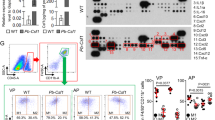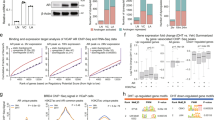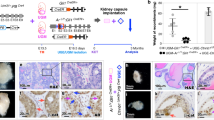Abstract
Proliferation of normal and malignant prostate epithelium is regulated by androgen stimulation via both the androgen receptor (AR)-positive stromal and epithelial cells. However, it is not known how AR expression is regulated in human prostate cells. We report that treatment of normal human prostate stromal cells (PrSCs) with type I IFN (alpha or beta), but not type II IFN (gamma), resulted in increased levels of AR protein. The maximal increase in AR protein levels was dependent on the dose and the duration of the IFN-alpha treatment. We found that the increase in AR protein levels was independent of de novo transcription and protein synthesis. Interestingly, the IFN-alpha treatment of PrSCs resulted in considerable nuclear accumulation of AR, stimulation of AR-mediated transcription of reporter genes, and retardation of cell proliferation. Furthermore, treatment of normal human prostate epithelial cells with IFNs (alpha, beta or gamma) also resulted in increased levels of AR protein. Together, our observations identify the androgen receptor as an IFN-regulated protein in normal human prostate stromal and epithelial cells and predict that IFN-induced levels of AR in prostate cells contribute to the regulation of androgen signaling.
This is a preview of subscription content, access via your institution
Access options
Subscribe to this journal
Receive 50 print issues and online access
$259.00 per year
only $5.18 per issue
Buy this article
- Purchase on Springer Link
- Instant access to full article PDF
Prices may be subject to local taxes which are calculated during checkout




Similar content being viewed by others
References
Abate-Shen C, Shen MM . (2000). Genes Dev 14: 2410–2434.
Abate-Shen C, Shen MM . (2002). Trends Genet 18: S1–S5.
Agoulnik IU, Krause WC, Bingman WE, Rahman HT, Amrikachi M, Ayala GE et al. (2003). J Biol Chem 278: 31136–31148.
Arnold JT, Isaacs JT . (2002). Endocr Relat Cancer 9: 61–73.
Bello D, Webber MM, Kleinman HK, Wartinger DD, Rhim JS . (1997). Carcinogenesis 18: 1215–1223.
Caraglia M, Marra M, Pelaia G, Maselli R, Caputi M, Marsico SA et al. (2005). J Cell Physiol 202: 323–335.
Chang C, Chodak G, Sarac E, Takeda H, Liao S . (1989). J Steroid Biochem 34: 311–313.
Chlenski A, Nakashiro K, Ketels KV, Korovaitseva GI, Oyasu R . (2001). Prostate 47: 66–75.
Choubey D . (2000). J Biol Regul Homeost Agents 14: 187–192.
Condon MS, Bosland MC . (1999). In vivo 13: 61–65.
Garraway LA, Lin D, Signoretti S, Waltregny D, Dilks J, Bhattacharya N et al. (2003). Prostate 55: 206–218.
Heinlein CA, Chang C . (2004). Endocr Rev 25: 276–308.
Henshall SM, Quinn DI, Lee CS, Head DR, Golovsky D, Brenner PC et al. (2001). Cancer Res 61: 423–427.
Janssen M, Albrecht M, Moschler O, Renneberg H, Fritz B, Aumuller G et al. (2000). Prostate 43: 20–30.
Kominsky SL, Hobeika AC, Lake FA, Torres BA, Johnson HM . (2000). Cancer Res 60: 3904–3908.
Lee DK, Chang C . (2003). J Clin Endocrinol Metab 88: 4043–4054.
Litvinov IV, Antony L, Isaacs JT . (2004). Prostate 61: 299–304.
Malmgaard L . (2004). J Interferon Cytokine Res 24: 439–454.
Nelson WG, De Marzo AM, DeWeese TL, Isaacs WB . (2004). J Urol 172: S6–S11.
Nelson WG, De Marzo AM, Isaacs WB . (2003). N Engl J Med 349: 366–381.
Olapade-Olaopa EO, MacKay EH, Taub NA, Sandhu DP, Terry TR, Habib FK . (1999). Clin Cancer Res 5: 569–576.
Ricciardelli C, Choong CS, Buchanan G, Vivekanandan S, Neufing P, Stahl J et al. (2005). Prostate 63: 19–28.
Roy AK, Chatterjee B . (1995). Crit Rev Eukaryot Gene Expr 5: 157–176.
Schlaak JF, Hilkens CM, Costa-Pereira AP, Strobl B, Frischauf AM, Kerr IM . (2002). J Biol Chem 277: 49428–49437.
Shenk JL, Fisher CJ, Chen SY, Zhou XF, Tillman K, Shemshedini L . (2001). J Biol Chem 276: 38472–38479.
Shou J, Soriano R, Hayward SW, Cunha GR, Williams PM, Gao WQ . (2002). Proc Natl Acad Sci USA 99: 2830–2835.
Sica G, Dell’Acqua G, Iacopino F, Fattorossi A, Marchetti P, van der Kwast TH et al. (1994). Urol Res 22: 33–38.
Smyth MJ, Cretney E, Kershaw MH, Hayakawa Y . (2004). Immunol Rev 202: 275–293.
Stark GR, Kerr IM, Williams BR, Silverman RH, Schreiber RD . (1998). Annu Rev Biochem 67: 227–264.
Untergasser G, Koch HB, Menssen A, Hermeking H . (2002). Cancer Res 62: 6255–6262.
Xin H, Curry J, Johnstone RW, Nickoloff BJ, Choubey D . (2003). Oncogene 22: 4831–4840.
Xin H, Pereira-Smith OM, Choubey D . (2004). Oncogene 23: 6209–6217.
Yeh S, Lin HK, Kang HY, Thin TH, Lin MF, Chang C . (1999). Proc Natl Acad Sci USA 96: 5458–5463.
Acknowledgements
We thank Dr N Weigel and L Shemshedini for reagents. An award from the Department of Veteran Affairs (Medical Research & Development Service) to DC supported this research. The Kimmel Research Scholarship Foundation supported ZB and SCC.
Author information
Authors and Affiliations
Corresponding author
Rights and permissions
About this article
Cite this article
Basrawala, Z., Alimirah, F., Xin, H. et al. Androgen receptor levels are increased by interferons in human prostate stromal and epithelial cells. Oncogene 25, 2812–2817 (2006). https://doi.org/10.1038/sj.onc.1209304
Received:
Revised:
Accepted:
Published:
Issue Date:
DOI: https://doi.org/10.1038/sj.onc.1209304
Keywords
This article is cited by
-
Antitumor activity of interferon-β1a in hormone refractory prostate cancer with neuroendocrine differentiation
Journal of Endocrinological Investigation (2017)
-
Expression, regulation and function of the ISGylation system in prostate cancer
Oncogene (2009)



